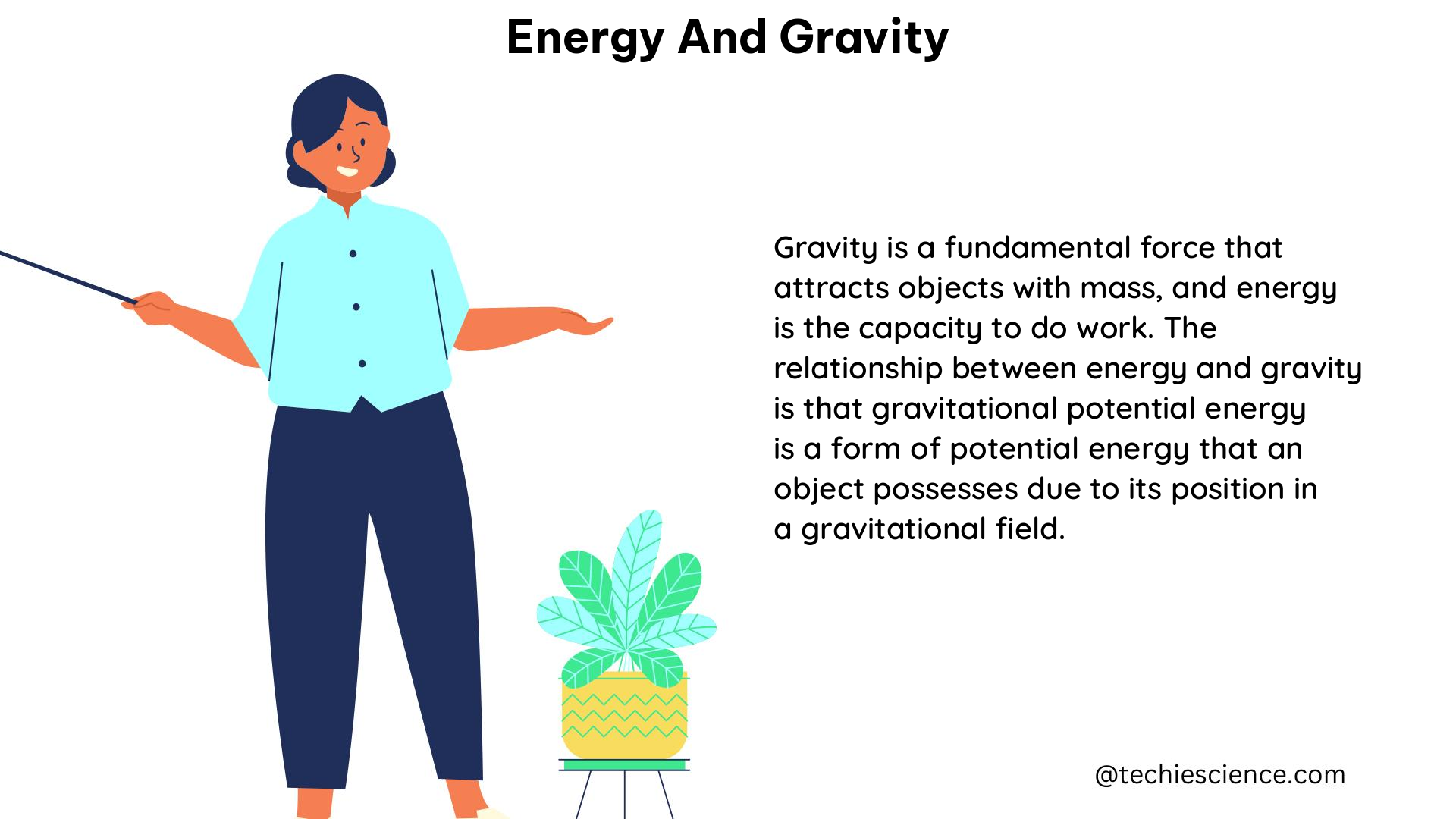Energy and gravity are two of the most fundamental concepts in physics, and understanding their intricate relationship is crucial for any student or enthusiast of the physical sciences. This comprehensive guide will delve into the intricacies of energy and gravity, providing a wealth of technical details, formulas, examples, and numerical problems to help you gain a deep understanding of these essential topics.
Understanding the Relationship between Energy and Gravity
Gravity is the force that attracts two objects with mass towards each other, while energy is the capacity to do work. These two concepts are closely intertwined, as gravity can influence the energy of an object, and the energy of an object can, in turn, affect the gravitational force acting upon it.
One of the most important forms of energy in the context of gravity is gravitational potential energy (GPE). Gravitational potential energy is the energy stored in an object due to its height above the ground or its distance from a massive object. The formula for gravitational potential energy is:
GPE = mgh
where m is the mass of the object, g is the acceleration due to gravity, and h is the height above the ground.
Another important form of energy is kinetic energy (KE), which is the energy of motion. The formula for kinetic energy is:
KE = 1/2 mv^2
where m is the mass of the object and v is its velocity.
Measuring the Strength of Gravity

To measure the strength of gravity, scientists use a variety of techniques, including:
- Dropping a Mass from a Known Height: By dropping a mass from a known height and measuring the time it takes to fall, scientists can calculate the acceleration due to gravity (g) using the formula:
g = 2h/t^2
where h is the height and t is the time taken for the object to fall.
-
Torsion Balance: A torsion balance is used to measure the gravitational attraction between two masses. By measuring the tiny twisting motion of a suspended rod, scientists can calculate the gravitational constant (G).
-
Pendulum Experiments: By measuring the period of a pendulum’s oscillation, scientists can calculate the acceleration due to gravity (g) using the formula:
T = 2π√(l/g)
where T is the period, l is the length of the pendulum, and g is the acceleration due to gravity.
The current best estimate for the gravitational constant, G, is 6.6743 x 10^-11 m^3 kg^-1 s^-2. However, there is some disagreement among scientists about the precise value of G, as some experimental results do not overlap.
Theoretical Explanations for Energy and Gravity
In addition to the quantifiable measurements of energy and gravity, there are also theoretical explanations for these fundamental concepts. One of the most important theories is the theory of general relativity, developed by Albert Einstein.
According to the theory of general relativity, gravity is not a force, but rather a curvature of spacetime caused by the presence of massive objects. This curvature of spacetime affects the motion of other objects, causing them to experience the force we call gravity.
The theory of general relativity has been confirmed by numerous experiments and observations, such as the bending of light by massive objects and the precession of the perihelion of Mercury.
Numerical Problems and Examples
To further solidify your understanding of energy and gravity, let’s explore some numerical problems and examples:
- Gravitational Potential Energy: Calculate the gravitational potential energy of a 50 kg object placed at a height of 10 meters above the ground, given that the acceleration due to gravity (g) is 9.8 m/s^2.
GPE = mgh
GPE = 50 kg × 9.8 m/s^2 × 10 m
GPE = 4,900 J
- Kinetic Energy: A 2,000 kg car is traveling at a speed of 20 m/s. Calculate the kinetic energy of the car.
KE = 1/2 mv^2
KE = 1/2 × 2,000 kg × (20 m/s)^2
KE = 400,000 J
- Pendulum Period: A pendulum has a length of 1 meter. Calculate the period of the pendulum’s oscillation, given that the acceleration due to gravity (g) is 9.8 m/s^2.
T = 2π√(l/g)
T = 2π√(1 m / 9.8 m/s^2)
T = 2.00 s
These examples demonstrate how the formulas and concepts discussed earlier can be applied to solve real-world problems involving energy and gravity.
Additional Resources and References
For further exploration and deeper understanding of energy and gravity, consider the following resources:
Reference:
1. Gravitational Potential Energy and Total Energy – OpenStax
2. How Do You Measure the Strength of Gravity? – NIST
3. Gravity – HyperPhysics
4. The Gravitational Constant (G) – CODATA
5. General Relativity – Stanford Online Course
By mastering the fundamentals of energy and gravity, you will gain a deeper understanding of the physical world around you and be better equipped to tackle more advanced topics in physics. Keep exploring, experimenting, and expanding your knowledge – the journey of discovery in the realm of energy and gravity is truly fascinating.

Hi,
I am Megha B R, I have completed my Post-Graduation in Solid State Physics and pursuing B. Ed. I am a Physics enthusiast. As an Academic writer, my goal is to reach the readers in a simplified manner through my articles.
Let’s connect through LinkedIn-